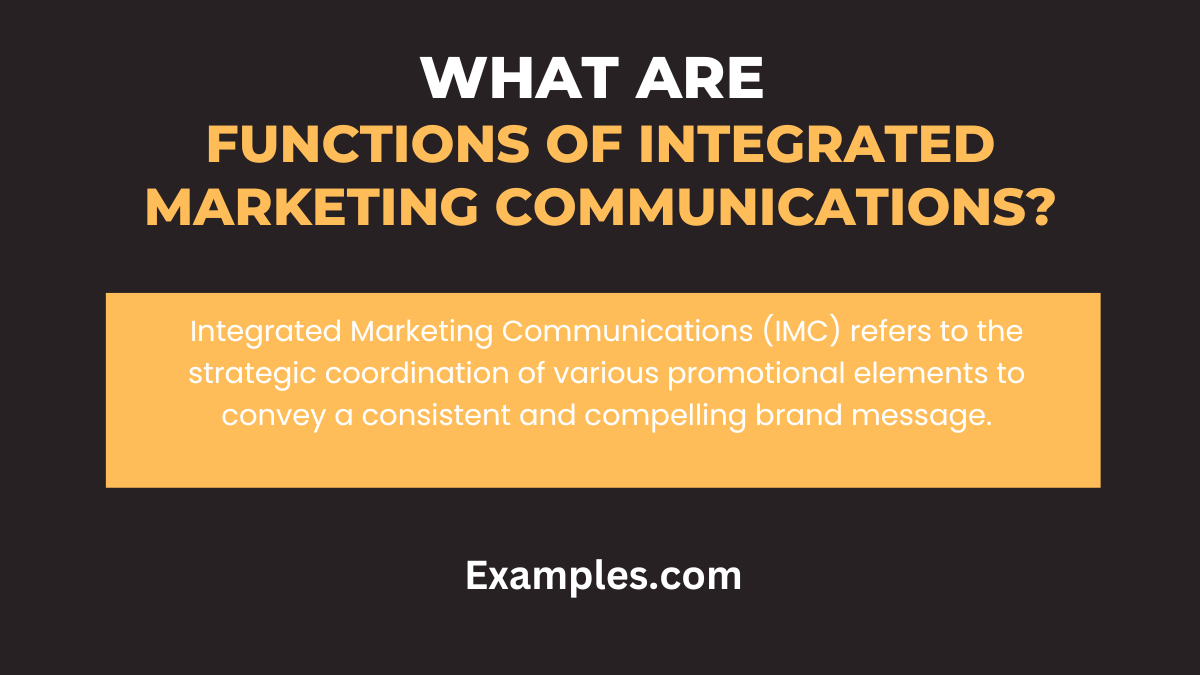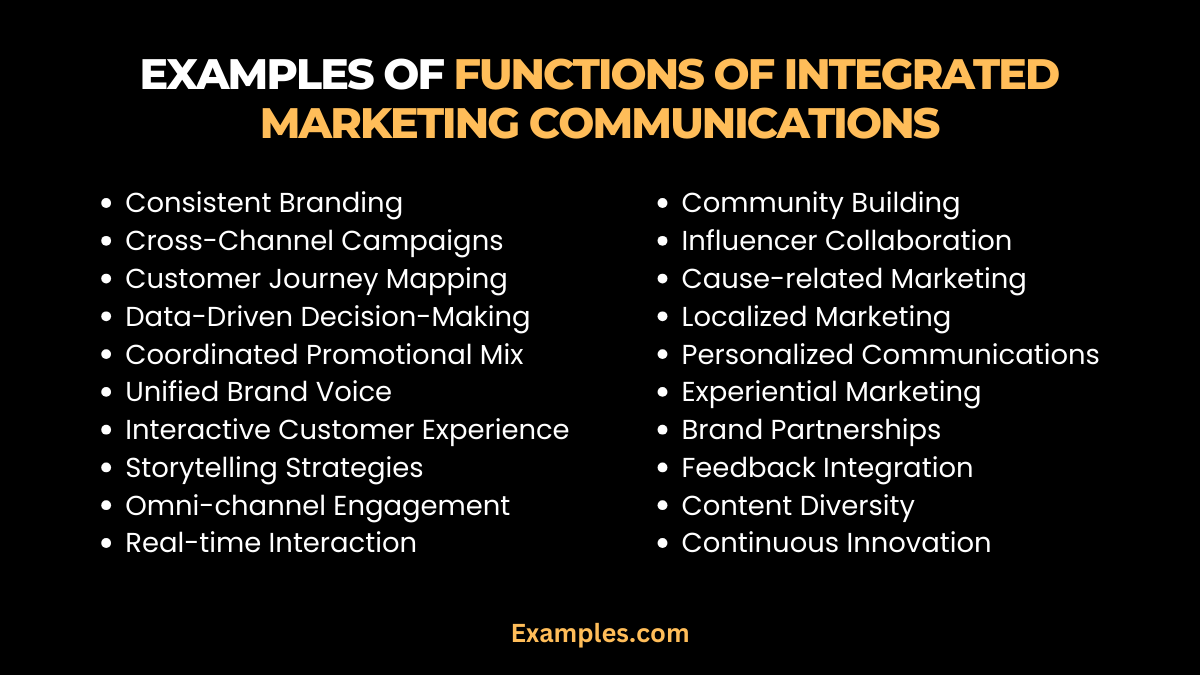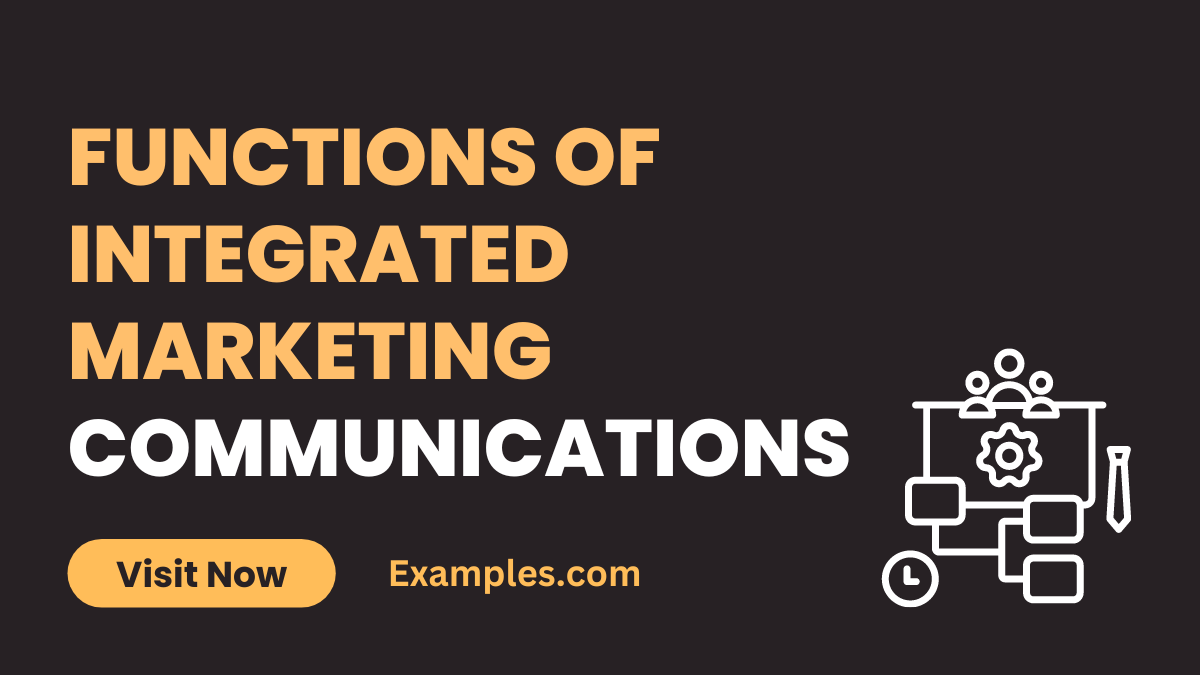19 Functions of Integrated Marketing Communications
Embark on a journey through the Functions of Integrated Marketing Communications (IMC), the linchpin of strategic brand communication. Gain a comprehensive understanding of IMC’s definition, trace its origin and history, and acquire actionable tips on implementing this powerful approach. Explore illustrative examples that showcase IMC’s prowess in orchestrating cohesive and impactful marketing campaigns. Elevate your marketing game with valuable insights and practical
What Are Functions Of Integrated Marketing Communications?

Integrated Marketing Communications (IMC) refers to the strategic coordination of various promotional elements to convey a consistent and compelling brand message. It unifies advertising, public relations, digital marketing, and other communication channels to create a seamless customer experience. IMC aims to enhance brand visibility, build customer relationships, and drive desired actions by ensuring that all communication efforts work harmoniously towards common objectives. This approach optimizes marketing strategies for greater impact and effectiveness.
20 Examples of Functions of Integrated Marketing Communications

Functions of Integrated Marketing Communications encompass a blend of strategies to reinforce brand messages consistently across various channels. These strategies, when applied effectively, ensure a cohesive brand narrative, resonating with the target audience, fostering engagement, and driving brand loyalty.
- Consistent Branding: Maintaining uniform brand visuals and tone across social media, website, and advertisements creates brand recognition and trust. Communicate the brand’s essence consistently to establish a recognizable identity.
- Cross-Channel Campaigns: Orchestrating synchronized campaigns across digital platforms, ensuring seamless messaging and experiences, boosts audience engagement and expands brand reach. Align content across platforms to amplify campaign impact.
- Customer Journey Mapping: Understanding and optimizing touchpoints in a customer’s journey enhances personalized interactions, tailoring messages to suit each stage of the buying process. Map customer journeys to align communication touchpoints effectively.
- Data-Driven Decision-Making: Utilizing consumer insights and analytics to refine communication strategies ensures relevance and resonance with the audience. Leverage data to enhance the accuracy and effectiveness of communication initiatives.
- Coordinated Promotional Mix: Integrating various promotional tools like advertising, sales promotions, and PR into a cohesive strategy amplifies the brand message and increases audience engagement. Coordinate diverse promotional tools to achieve unified messaging.
- Unified Brand Voice: Maintaining a consistent tone and messaging in content creation across platforms strengthens brand identity and fosters customer trust. Develop and adhere to a unified brand voice in all communications.
- Interactive Customer Experience: Creating engaging and interactive experiences through quizzes, polls, or live events fosters deeper customer engagement and loyalty. Encourage active participation to enhance the customer experience.
- Storytelling Strategies: Crafting compelling brand narratives that connect emotionally with the audience helps in creating long-lasting brand impressions. Employ storytelling techniques that resonate with the target audience.
- Omni-channel Engagement: Providing a seamless experience across various channels ensures accessibility and engagement regardless of the platform. Seamlessly integrate channels to facilitate a smooth customer journey.
- Real-time Interaction: Prompt and personalized responses to customer queries or comments on social media platforms demonstrate attentiveness and foster brand credibility. Prioritize and promptly engage with customers in real-time interactions.
- Community Building: Building communities around the brand creates a loyal customer base and fosters brand advocacy. Encourage user-generated content and engagement within brand communities.
- Influencer Collaboration: Partnering with influencers aligning with brand values amplifies reach and credibility among niche audiences. Collaborate with influencers for authentic brand endorsements.
- Cause-related Marketing: Associating with social causes resonating with the brand ethos enhances brand perception and engages socially conscious consumers. Align with relevant causes to communicate shared values.
- Localized Marketing: Tailoring communication strategies to specific geographic regions or cultures personalizes the brand experience and enhances relatability. Customize messages to suit local preferences and sensibilities.
- Personalized Communications: Delivering customized messages based on individual preferences or behaviors enhances engagement and fosters a deeper connection with customers. Employ personalized communication strategies for enhanced relevance.
- Experiential Marketing: Creating memorable and immersive brand experiences through events or pop-ups engages customers on a personal level, leaving a lasting impression. Design unique and interactive brand experiences.
- Brand Partnerships: Collaborating with complementary brands for joint campaigns or products expands brand reach and creates mutual value. Seek partnerships that complement brand values and objectives.
- Feedback Integration: Actively incorporating customer feedback into communication strategies demonstrates responsiveness and fosters stronger customer relationships. Regularly integrate and act on customer feedback.
- Content Diversity: Utilizing various content formats like videos, blogs, and infographics diversifies engagement and caters to different audience preferences. Experiment with diverse content formats for wider audience appeal.
- Continuous Innovation: Embracing innovation in communication strategies ensures staying ahead in a rapidly evolving landscape. Continuously explore and implement innovative approaches to communication.
Functions Of Integrated Marketing Communications For Business

Integrated Marketing Communications (IMC) plays a pivotal role in amplifying a business’s messaging and fostering brand growth. Understanding the functions of IMC within a business context is crucial for achieving cohesive and effective communication. Here’s a comprehensive guide to the functions of Integrated Marketing Communications tailored for businesses.
- Consistent Branding Across Channels: Maintaining a uniform brand identity across various channels is a fundamental function of IMC. From social media to traditional advertising, ensuring that your brand’s visual elements and messaging remain consistent builds a strong and recognizable brand presence.
- Cross-Channel Campaign Coordination: Businesses benefit from IMC by orchestrating synchronized campaigns across multiple channels. Coordinated campaigns ensure that your message reaches your target audience consistently, leveraging the strengths of each platform for maximum impact.
- Customer Journey Mapping: Understanding the customer journey is essential. IMC involves mapping out the customer’s experience from awareness to purchase and beyond. By identifying touchpoints and tailoring communication at each stage, businesses can optimize customer interactions.
- Data-Driven Decision-Making: IMC relies heavily on data analytics to make informed decisions. Businesses analyze consumer behavior, preferences, and market trends to fine-tune their communication strategies, ensuring that messages resonate with the target audience.
- Coordinated Promotional Mix: Integrating various promotional tools such as advertising, sales promotions, and public relations is a key function. A well-coordinated promotional mix ensures that marketing efforts are aligned, creating a harmonious and impactful brand message.
- Unified Brand Voice: Consistency in brand voice is crucial for businesses. IMC helps in developing and maintaining a unified brand voice across all communication channels, creating a coherent and authentic brand identity.
- Interactive Customer Experience: Businesses leverage IMC to create engaging and interactive experiences for customers. Through quizzes, polls, and live events, companies encourage active participation, fostering a deeper connection with the audience.
- Storytelling Strategies: The art of storytelling is a powerful function of IMC. Crafting compelling narratives that resonate emotionally with the audience helps businesses create a lasting and meaningful impression.
- Omni-channel Engagement: In a world where consumers interact with brands across multiple channels, IMC ensures an omni-channel approach. This means providing a seamless and integrated experience, irrespective of the platform.
- Real-time Interaction: Prompt and personalized responses in real-time are vital for businesses. IMC emphasizes actively engaging with customers on social media platforms, demonstrating attentiveness and building credibility.
Functions of Integrated Marketing Communications for Social Media
In the dynamic realm of social media, the functions of Integrated Marketing Communications (IMC) play a pivotal role in constructing a cohesive brand presence, fostering engagement, and driving conversions. By seamlessly integrating various communication channels, businesses can optimize their social media strategies to create a unified brand message. Here’s a comprehensive guide on the key functions of IMC for social media.
- Consistent Brand Messaging: Ensuring a uniform brand voice and visual identity across all social media platforms is foundational. Consistency builds brand recognition and fosters trust among followers.
- Cross-Platform Synchronization: Harmonizing communication efforts on diverse social media channels ensures a synchronized brand narrative. Coordinated content strategies amplify the impact and reach of social media campaigns.
- Audience Segmentation: IMC allows for the segmentation of target audiences on social media, tailoring messages to specific demographics. This personalized approach enhances relevance and engagement.
- Content Strategy Integration: Integrating content strategies across social media aligns messaging with broader marketing goals. From blog posts to video content, a cohesive strategy boosts audience interest.
- Data-Driven Social Media Campaigns: Leveraging analytics and insights facilitates data-driven decision-making. By understanding audience behaviors, brands can refine social media campaigns for optimal performance.
What are the benefits of integrated marketing communication and what is its role?
Integrated Marketing Communication (IMC) is a strategic approach that unifies and aligns various marketing communication elements to deliver a consistent brand message. The benefits of IMC are multifaceted, contributing to enhanced brand visibility, customer engagement, and overall business success.
- Consistent Brand Image:
- Role: IMC plays a pivotal role in maintaining a uniform brand image across diverse communication channels.
- Benefit: Consistency reinforces brand identity, fostering trust and recognition among consumers.
- Increased Brand Visibility:
- Role: IMC ensures that the brand is prominently present across various platforms and touchpoints.
- Benefit: Enhanced visibility expands the brand’s reach, making it more accessible to a wider audience.
- Effective Resource Utilization:
- Role: IMC integrates different communication tools to streamline resource allocation.
- Benefit: Optimal resource utilization ensures cost-effectiveness in marketing efforts.
- Enhanced Customer Engagement:
- Role: IMC facilitates cohesive and engaging customer interactions.
- Benefit: Improved engagement strengthens the customer-brand relationship, fostering loyalty.
- Improved Message Clarity:
- Role: IMC coordinates messaging to ensure clarity and avoid conflicting information.
- Benefit: Clear messaging helps consumers better understand the brand’s value proposition.
- Holistic Customer Experience:
- Role: IMC integrates touchpoints to create a seamless customer journey.
- Benefit: A holistic experience enhances customer satisfaction and loyalty.
- Adaptability to Market Changes:
- Role: IMC allows for agile adjustments to changing market dynamics.
- Benefit: The ability to adapt ensures the brand remains relevant and responsive.
- Measurable Results:
- Role: IMC enables the tracking and measurement of marketing efforts.
- Benefit: Measurable results provide insights for continuous improvement and optimization.
- Competitive Edge:
- Role: IMC helps differentiate the brand in a crowded market.
- Benefit: A distinct identity gives the brand a competitive advantage.
- Maximized Impact:
- Role: IMC coordinates efforts for a more impactful marketing strategy.
- Benefit: Combined efforts amplify the brand message, making a stronger impression.
How Do Integrated Marketing Communications Work?
Integrated Marketing Communications (IMC) amalgamates various marketing elements into a cohesive strategy to communicate a consistent brand message across multiple channels. The core principle is to deliver a unified message, enhancing brand perception and customer engagement.
Understanding Audience Segmentation: Effective IMC begins by comprehending the audience’s demographics, behaviors, and preferences. Skills in market research and data analysis aid in segmenting audiences for targeted communication strategies.
Crafting a Unified Brand Message: IMC aligns diverse marketing channels, ensuring a consistent brand voice and message across platforms. This requires honed skills in copywriting, visual storytelling, and content creation to resonate with diverse audiences.
3. Leveraging Multi-Channel Platforms: Proficiency in utilizing various channels like social media, email, advertising, and PR is crucial. The ability to adapt communication styles for each platform optimizes engagement and impact.
4. Creating Integrated Campaigns: IMC involves creating synchronized campaigns that resonate across channels. Skills in campaign planning, coordination, and implementation facilitate cohesive messaging and consistent brand representation.
5. Embracing Technology and Innovation: Staying updated on emerging technologies and trends in digital marketing enhances communication skills. Proficiency in utilizing tools for analytics, automation, and personalization is imperative
In conclusion, understanding the functions of Integrated Marketing Communications (IMC) is pivotal for crafting impactful brand strategies. By seamlessly blending diverse marketing elements, IMC ensures consistent messaging, targeted campaigns, and enhanced audience engagement. This comprehensive guide underscores the importance of honing various communication skills to navigate the dynamic landscape of IMC successfully, fostering brand success and customer connection.



